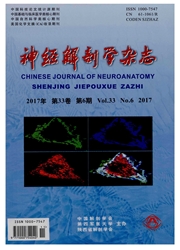

 中文摘要:
中文摘要:
目的:探究miR-199a通过靶向调节ATPl3A2对6-OHDA诱导的PC12细胞氧化应激的影响。方法:收集正常大鼠和帕金森(PD)模型大鼠脑组织,培养6-OHDA诱导的PC12细胞,利用Real-time PCR检测miR-199a和ATPl3A2的表达,Western Blot检测ATP13A2表达。分别转染miR-199a类似物和miR-199a抑制剂,利用ELISA检测ROS、MDA、SOD和GSH—Px的表达。双荧光素酶报告基因检测miR-199a与ATP13A2的靶向关系。Western Blot法检测ATP13A2和JNK/c—Jun表达的影响。MTT法检测细胞增殖的影响。结果:PD脑组织和细胞中miR-199a表达显著降低,ATP13A2表达显著升高(P〈0.01)。过表达miR-199a可显著降低6-OHDA诱导的PC12细胞的ROS、MDA活性,升高SOD、GSH—Px活性(P〈0.01)。miR-199a过表达显著降低荧光素酶报告基因的荧光强度,而结合位点突变后荧光素酶活性不变(P〈0.01)。过表达miR-199a显著降低ATPl3A2的表达并抑制JNK和c—Jun的磷酸化水平,茴香霉素则升高ATPl3A2表达并激活JNK和c—Jun的磷酸化水平,过表达miR-199a且给予茴香霉素处理可使JNK和c—Jun的磷酸化水平恢复到6-OHDA-PC12组水平(P〈0.01)。过表达miR-199a抑制6-OHDA诱导的PC12细胞增殖,茴香霉素则促进其增殖,过表达miR-199a且给予茴香霉素处理可使细胞增殖率恢复到6-OHDA—PC12组水平(P〈0.01)。结论:miR-199a可通过靶向调节ATPl3A2抑制6-OHDA诱导的PC12细胞氧化应激并抑制JNK/c—Jun活化。
 英文摘要:
英文摘要:
Objective: To investigate the role of miR-199a on the 6-hydroxydopamine (6-OHDA)-induced oxidative stress in PC12 cells by targeting ATP13A2. Methods: Brain tissues of normal rat and Parkinson disease (PD) model rat were collected, and the PC12 ceils treated with 6-OHDA were cultured. The levels of miR-199a and ATP13A2 were detected by Real-time PCR analysis, the protein level of ATP13A2 was detected by Western Blot analysis. PC12 cells were transfected with miR-199a inhibitor and treated with miR-199a inhibitor respectively. The expressions of ROS, MDA, SOD and GSH-Px were measured by ELISA analysis. Then, the target relationship of miR-199a and ATP13A2 was determined by dual-luciferase reporter gene assay. In addition, the effects of miR-199a on the ATP13A2 and JNK/c-Jun expressions were assessed by Western Blot analysis. The role of anisomycin on ceils proliferation was detected by MTr assay. Results: The expression levels of miR-199a were significantly decreased and ATP13A2 was increased in PD brain tissues and cells (P 〈 0.01 ). And, miR-199a overexpression remarkably decreased the ROS, MDA levels and increased the SOD, GSH-Px levels in the PC12 cells treated with 6-OHDA (P 〈 0.01 ). The results showed that the relative luciferase activity was significantly decreased in PC12 cells transfected with miR-199a mimics, but the fluorescence activity was not changed after the binding site mutation (P 〈 0.01 ). Overexpression of miR-199a decreased the ATP13A2 expression and reduced the JNK and c-Jun phosphorylation levels, but anisomycin increased the ATP13A2 expression and activated the JNK and c-Jun phosphorylation levels (P 〈 0.01 ). The phosphorylation levels of JNK and c-Jun were restored to the expressions in 6-OHDA-PC12 group by co-treatment of miR-199a overexpression and anisomycin. MiR-199a overexpres- sion inhibited the 6-OHDA induced the PC12 cells proliferation, while anisomycin promoted the cells proliferation. More- over, the cells proliferation rate was restored t
 同期刊论文项目
同期刊论文项目
 同项目期刊论文
同项目期刊论文
 期刊信息
期刊信息
